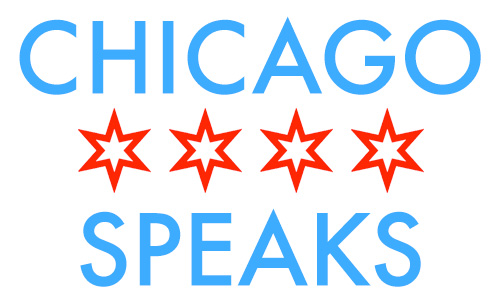| « The Hobbit: The Battle of the Five Armies & The Babadook | Into the Woods, Big Eyes, Unbroken, The Gambler, Mr. Turner & Zero Motivation » |
Chicago Speaks Mon Dec 22 2014
Chicago Speaks: American Sign Language, as Signed by Poet and Storyteller Peter Cook
 As a global city, Chicago is home to many languages besides English. Chicago Speaks profiles speakers of these languages, and shares some of their personal stories along the way.
As a global city, Chicago is home to many languages besides English. Chicago Speaks profiles speakers of these languages, and shares some of their personal stories along the way.
As a student at the National Technical Institute for the Deaf at the Rochester Institute of Technology, Peter Cook was a graphic design major who wrote poetry on the side, composing his poems in English and translating them into American Sign Language. Then, in 1984, he attended a poetry workshop Allen Ginsberg gave at the school with the Deaf poet Robert Panara.
"Allen was reading from Howl, and there was a sign language interpreter," Cook recounts. "He got to the words 'hydrogen jukebox' and he stopped."
The documentary The Heart of the Hydrogen Jukebox features footage of what happened next. "What is a hydrogen jukebox in sign language?" Ginsberg asks. "Does any kind of interesting sparkle come through with that combination? Or does that go dead in translation?"
In response to Ginsberg's question, the Deaf poet Patrick Graybill walks to the front of the room and, in Cook's words, "created in space a jukebox, and the record player ...and then it explodes." The audience erupts in applause. (The interpreter had only spelled the English words.)
"Allen Ginsberg said, 'That's it!'" Cook recalls. "He said modern American poets try to make their work as visual as possible, and that Patrick had done it instantly. And he said he was jealous. That workshop had big impact on me. It changed my life. I realized that I could let go of what I was writing down... and I could instead just really create poetry in ASL by itself."
Flying Words
Soon, Cook became an integral part of the ASL poetry scene that flourished in the 1980s in Rochester, New York. "A lot of people now will refer to that as a Deaf Rochester poetry movement that was happening, and I just happened to be there," he explains. During that period, he and a hearing collaborator founded the Flying Words Project, a two-person troupe that still regularly stages ASL poetry.
Today, Cook combines education with his performance work. He's acting chair of the Department of ASL-English Interpretation at Columbia College Chicago, where he started teaching as a part-time instructor in 1993.
ASL 101
When students start learning ASL, he notes, one of the biggest challenges they face is paying attention to nonmanual signs.
"When they're learning ASL, they want to look at what your hands are doing and only what your hands are doing," Cook explains. "But that's not enough. You have to watch everything that's going on in the face. . . . So, for example, the eyebrows are part of the sentence. If I were to ask you a yes-or-no question -- like, do you like ice cream? -- the eyebrows go up. That's a formal part of the grammar of ASL."
Many elements of ASL have roots in French Sign Language (also known as LSF, or Langue des Signes Française). Laurent Clerc, who in 1817 cofounded the first American school for the deaf, had learned LSF in his native France and used it as his medium of instruction. The emergence of ASL is often attributed to the contact between LSF and the local sign languages used by the Connecticut school's first students.
ASL and LSF are not mutually intelligible. But they are more closely related than, say, ASL and British Sign Language. "People think everyone signs the same all over the world," Cook explains. "But of course each country has their own [sign language], because it's related to culture."
Another common misconception is that ASL is based on visual depiction; in fact, most of its signs are arbitrary, bearing no visual resemblance to their referents.
"Born Again Deaf"
The 51-year-old Cook, who has been deaf since he was 3, didn't learn ASL until he was 19. As a child, he attended a school that taught speech and lip reading and did not allow signing -- an approach, opposed by many in the Deaf community, that declined in popularity after a heyday spanning the end of the 19th century and the first half of the 20th. Since then, ASL has gained ground in education, but the history of debates about deaf children's schooling is complex and ongoing.
The Deaf community distinguishes between lowercase-d deaf, which refers to the condition of not hearing, and capital-d Deaf, which denotes a shared language and cultural identity. Even before Cook attended Ginsberg's workshop, learning that language -- and assuming that identity -- had changed his life.
"From the moment I got [to Rochester], it was a new world," he recalls in The Heart of the Hydrogen Jukebox, which features some of his work. "I felt like a B.A.D.: born again Deaf."
ASL-English interpretation provided by Candace Hart-Hathaway, a sign language interpreter at Columbia College Chicago.








